NIKON S3 - Remake 2000 and Comparison with SP
(c) Frank
Mechelhoff
Neu October 2022
Diese Seit auf
Deutsch
The
predecessor : NIKON S2
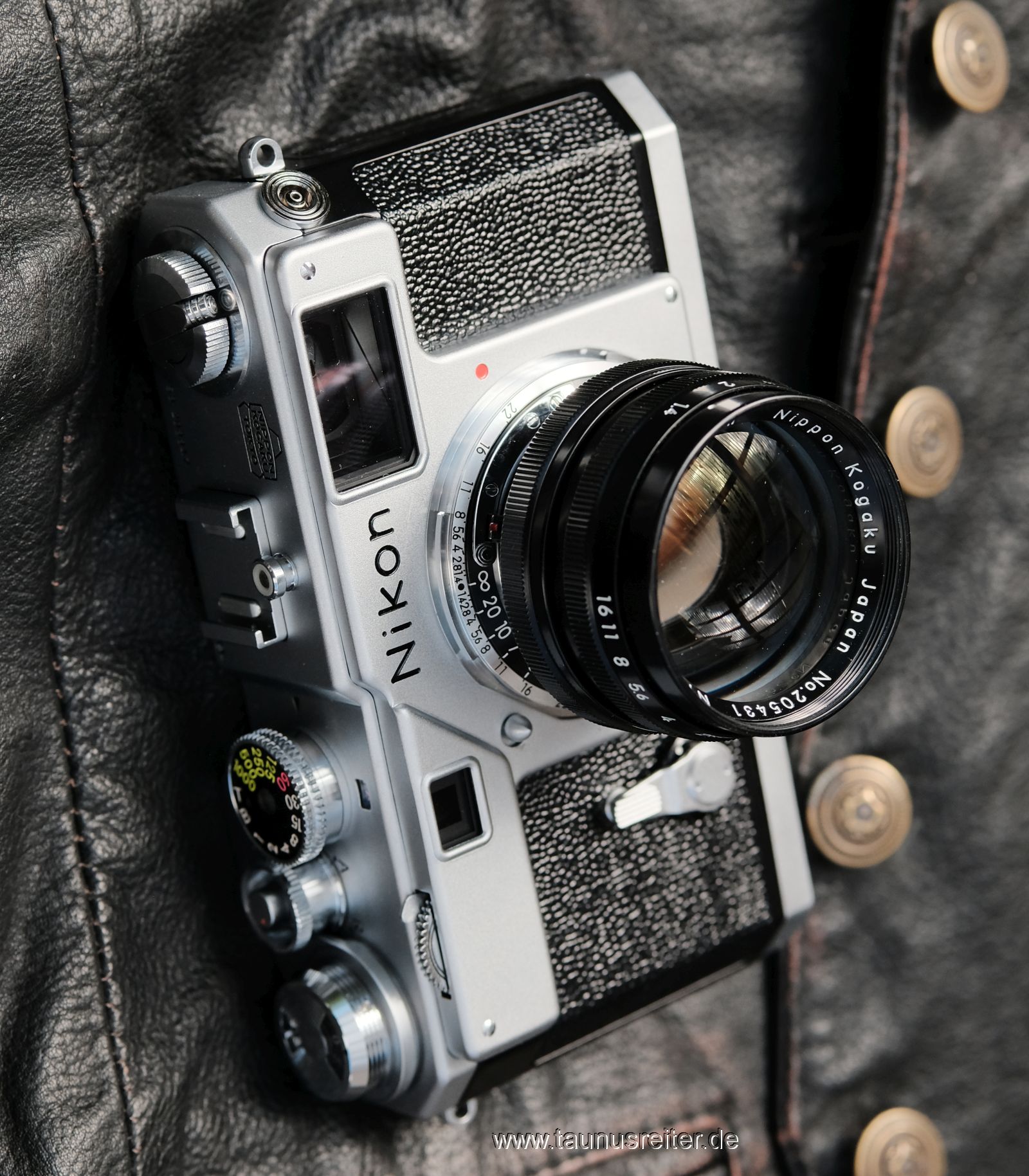
In 1964,
Nikon discontinued production of their rangefinder cameras
(also called the S-series or S- mount) in
favor of their SLRs (F-mount: Nikon F,
Nikkormat). It can be
assumed that this was preceded by an eminent drop in demand. The last model
was the S3 "Olympic", named by 1964 Tokyo
Olympics, the first which took place
in Asia.
In 1957 Nikon launched the SP, a beautifully
designed professional camera, top of the range. As a special feature, it had
two viewfinders: one a 1:1 lifesize rangefinder with
four framelines (50, 85, 105 aand 135mm) plus an additional wide-angle
viewfinder for 28 and 35 mm, albeit quite small (0.4x).
Until the Leica M6 (1984) this was the only camera with a
viewfinder for 28mm focal length. At that time, no competitor
could offer framelines for six focal lengths,
and what's more, with 1:1 "lifesize" magnification.
The slightly cheaper S2 from 1954, although probably the most important
camera ever built by NIKON, seemed already outdated compared to the new top
model SP - only three years after its market launch - mainly
because of its viewfinder (with only a 50mm frameline) and the
double shutter speed wheel that rotates when the shutter is
released. Although
it was still sold out, an update was due and expected.
The Nikon S3
This came one year later,
in 1958 : The S3, a semi-professional model, placed a little below
the SP, superseded the S2. Weight at 580g, about 20g lighter
than the SP, apart from the viewfinder, signature and
nameplate, both models were technically largely identical. Priced at ¥86,000 (domestic
price in Japan), it was not far below the SP (¥98,000 - which
converts to 3.860 € in 2023 prices, plus taxes),
the most expensive Japanese 35mm camera, but not much
above the S2 at ¥83,000 (each
with f/1.4 lens). In addition, it offered a self-timer, the
modernized shutter (like the SP or F) and a viewfinder
with three framelines (35/50/105
mm). Other than the SP, these were not parallax-corrected or
reflected, but only projected, and were somewhat thicker
and protruding than these on the S2. Those who look into the
viewfinder for the first time may be irritated by the
three prominent frames, but you get used to it.

Image Nikon S2 top left,
Nikon S3 "Millennium" bottom right. S3 with larger viewfinder
opening, self-timer and modified lettering.
Apart from that offered a "lifesize" (1:1)
viewfinder with 35mm frame, then only the Canon P (populaire), which appeared a year after the Nikon S3 and
(purely "accidentally", I guess...) had the same technical
characteristics as the Nikon S3, but added a
parallax-corrected viewfinder. A shiny design as well, for
Leica screw-mount lenses, at ¥52,700 - 1/3
cheaper, and probably therefore more successful in terms of
sold items..!
Units sold
|
|
|
NIKON S2
|
|
|
56.715 (1954 for 5 years)
|
|
|
NIKON S3
|
CANON P
|
LEICA M2
|
14.310 (1959 for 3 years) + ca. 8.000
(remake)
|
95.000 (1958 for 3
years)
|
85.000 (1958 for 9
years)
|
NIKON SP
|
CANON 7 (inkl.
7S/7Sz)
|
LEICA M3
|
22.348 (1957 for 5 years) + 2.500 (remake)
|
157.000 (1961 for
7years)
|
227.000 (1954 for 12
years)
|
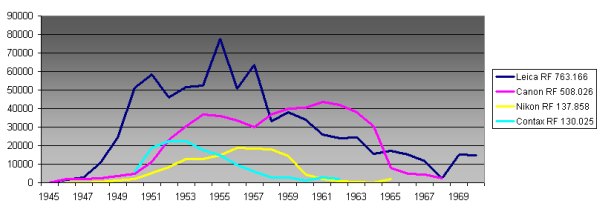
Statistics Production of rangefinder
cameras 1945-1970 : post-war boom and end in the 1960's.
The peak was reached in
1955 (Leica M3). The innovations of the late 1950's could not stop
the decline.
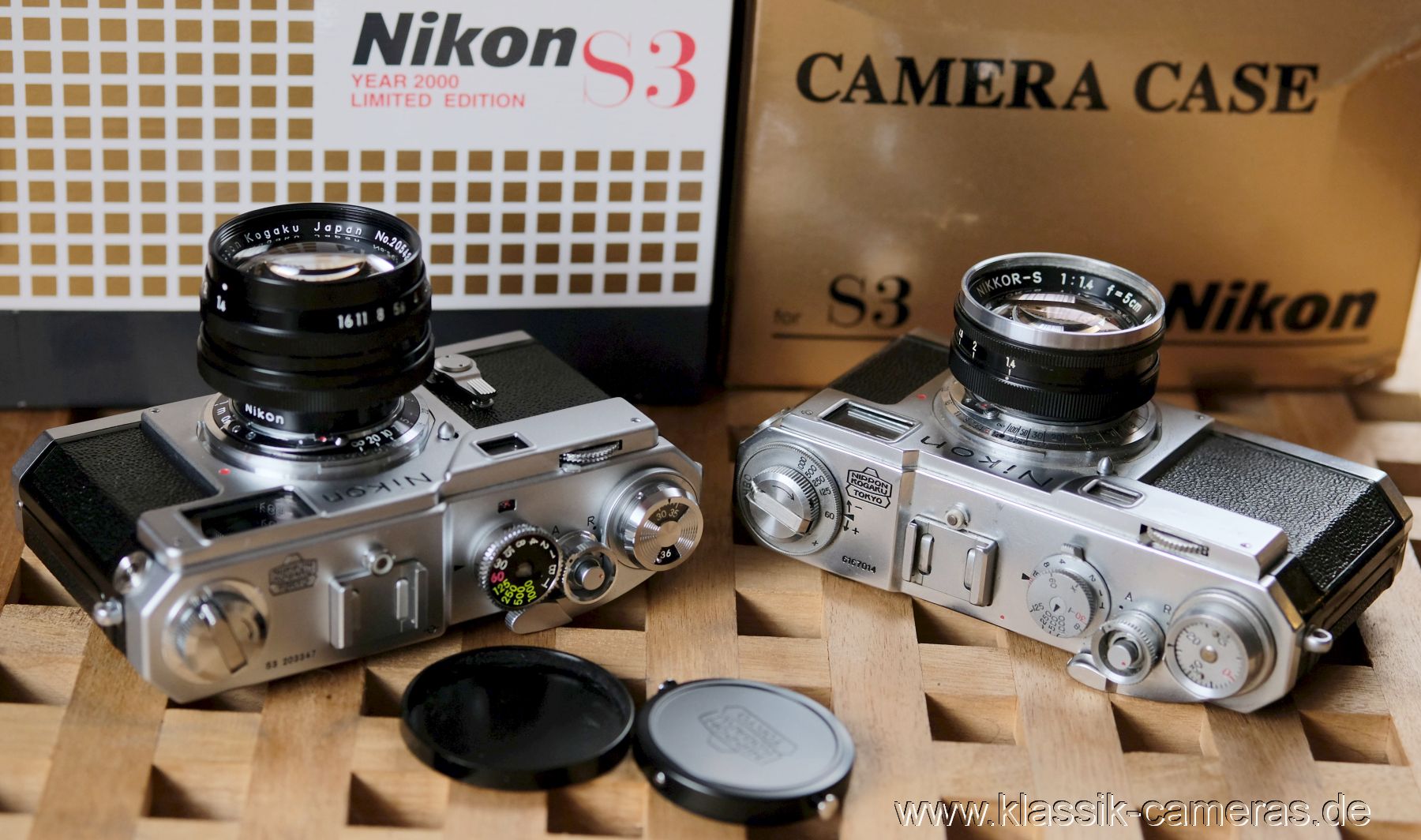
S3 Millenium and S2 with
associated lenses - again for size comparison. The updates to the shutter
speed wheel and frame counter are clearly visible. The modernized outfit suits
the S3 extremely well.
Collector
status before 2000
After the end of the NIKON rangefinder series in 1964,
a collector's cult developed around it over the next two decades, quite
comparable to LEICA - mainly in America and Japan. In Germany, legal disputes with
Zeiss-Ikon (and their close connection to photo shops) that
lasted well into the 1960s ensured that they did not even go
into business! As
a result, the Nikon rangefinder cameras were generally less well
known in Europe - also because of the smaller quantities
compared to LEICA - until the Internet made their existence
generally known.
Interestingly, there was not the same cult of
collectors around CANON Rangefinder cameras (the production of which was
discontinued somewhat later than the Nikons, namely in 1968), or
if , then it did not result in similar collector's
prices. However,
CANON's original prices were also slightly lower than
NIKON's (and slightly lower than LEICA's) and their built
numbers were generally slightly higher; so the offer is bigger. You also have to give the
NIKONs credit for looking similarly chic and iconic to LEICA,
while some CANON cameras from the 1960s (namely their SLRs) lack
this elegance. The
eye also buys.
The remake of the S3 :
"Millennium" Edition
The
collector's cult surrounding NIKON vintage cameras, combined
with the high prices and a certain demand, made NIKON decide
to bring a remake of the S3 onto the market, more
than 30 years after the end of production - of course with the
newer "Olympic" lens, and Multi-Coating (1964
all lenses were single-coated). Although still largely
"mechanical" cameras such as the FM2 were still being built at
the time, the design and manufacturing hurdles were enormous -
as Nikon later largely
admitted honestly . The
old production tools were no longer available and had to be
rebuilt, and the camera had to be completely redesigned with
CAD ( reverse engine ering). Later,
production and assembly took place much slower than planned,
because after this long time, the special precision know-how
was long since retired! Next it turned out that the number of pieces had been calculated too optimistically; sales were rather sluggish. Despite the enormous prices,
NIKON does not make a profit with the cameras, building them
was purely a matter of brand image. And,
predictably, there was criticism from collectors that it
wasn't the top-of-the-line SP that had been replicated, but the S3 only.
Allegedly, NIKON
disassembled some of the cameras and repainted them in black, the more sought-after "collector's colour".
Five years later, NIKON did
this process again for the remake of the SP - now taking into account the desire for the top
model and black color from the start - together with the
35/1.8 lens (again multi-coated) that is also coveted by
collectors and in a "more limited" quantity. Now, however, it was been
criticized that the titanium shutter of the later series (and
the F) was not installed, but the fabric shutter of the first model. An attempt was made to
prevent a price drop like that of the S3 remakes by
eliminating photo business (sales directly from factory) and
was successful: the prices of the SP "Limited Edition"
remained stable and today (2022) are around the 2.5-fold of
the S3 "Millenium". There was no foreign sale. However, the supply of "new
in the box", with all papers, unused cameras is already very
large!
| S3
Millennium, Chrome (Oct 2000) |
¥480,000
incl. domestic tax (~ €5,000)
|
Quantity
(supposedly) 8,000 |
| S3
Millenium, Black (Jun 2002) |
¥530,000 incl. domestic
tax (~ €4,580) |
Quantity 2,000 |
SP
Limited Edition, Black (Jan-Jun 2005)
|
¥724,500including
domestic tax (~ €5,200) |
Quantity 2,500 |
(The exchange rate of the yen
fluctuated quite a lot in those years, between 1.10 and 0.70
EUR per 100 JPY)
Nikkor-P.C 10.5cm
f/2.5
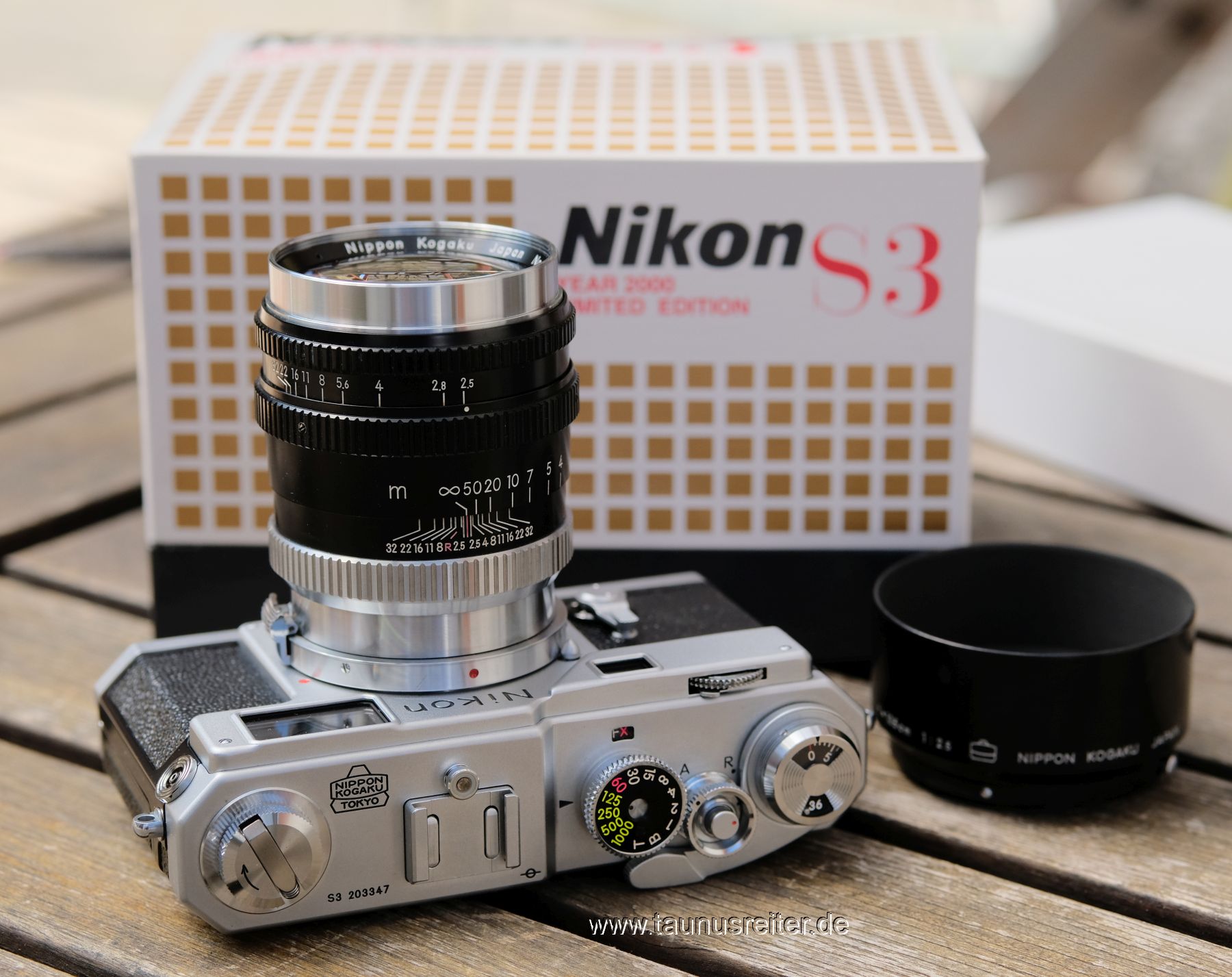
Nikon S3 Millenium with Nikkor-PC 10.5cm f/2.5 in latest version, with rare metric distance
scale. Almost
all Nikon rangefinder lenses have distance scales in
feet only. High performance portrait
lens with legendary reputation, Sonnar design (link to story
at NIKON, 1001 tales #45, by Haruo Sato). 1954 as the first
volume black Nikon lens ( enamelled aluminum ) on the market and established more than a mere
fashion, but the modern lens style.
All Nikon rangefinder cameras
have two lens mounts: one internal bayonet with scale and coupled focussing helicoid
for 50mm lenses, and one External bayonet, not coupled to the helicoid for lenses
with own helicoid and focus ring, for all other focal lengths
(or the last version of the 50/1.1 lens, which was too heavy
for proper focusing with internal bayonet and focussing
wheel). The
focussing wheel in front of the shutter button can , but does not
have to be used. This is only practical with light lenses,
the "Olympic" 50/1.4 isn't that easy to focus by the wheel.
W-Nikkor
3.5cm 1:2.5
The third lens presented here, suitable for the 35mm
viewfinder frame of the S3, is a wide-angle :
The compact, six-elemets W-Nikkor 3.5cm 1:2.5 , and mounted to the external bayonet as well. A bit soft at open aperture,
it is very sharp and suitable for landscape shots when stopped
down a bit. Here
the later (2nd) version in black. The aperture is set by the
serrated filter ring, not visible in the above-look. There was a final, 3rd
variant with a "hill and valley" focus ring and silver
aperture ring, corresponding to the 35/1.8, which is quite
rare. Link to the story at Nikon
(1001 nights tale #37 by Haruo Sato).
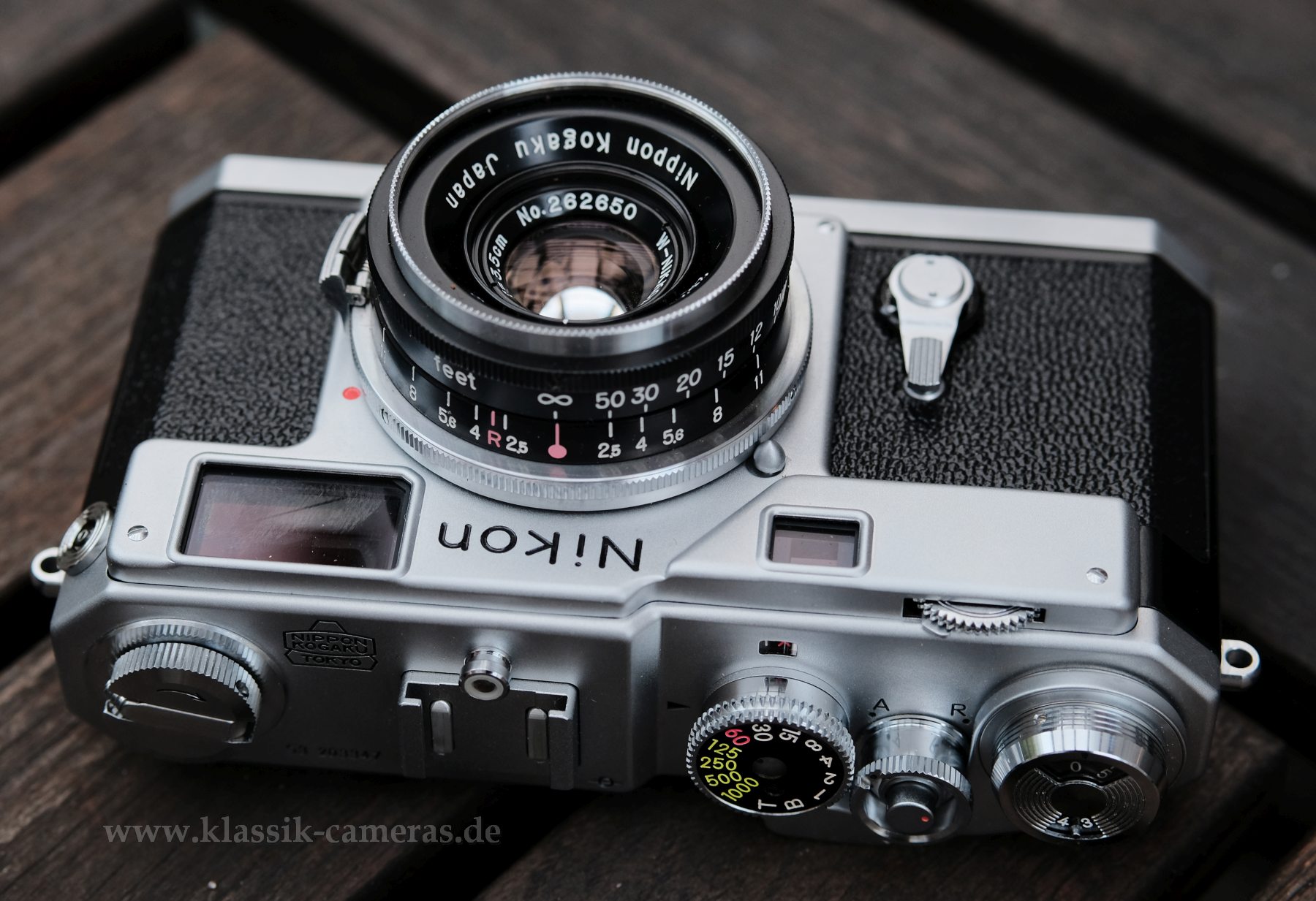
W-Nikkor
2.8cm 1:3.5
The 28mm fits the SP's
wide-angle viewfinder and is also shown here, in the first
(brass/chrome) version. It was the first Nikon wide
angle with 28mm and came out a short time after the Canon
Serenar 28/3.5 (with Leica screw thread), both are six-element
Gaussian designs. It is very similar in size and shape to the 35/2.5,
so in the chrome frame it is less easy to confuse theses
two! Link to the story at Nikon
(1001 nights ta le #79 by Haruo Sato)
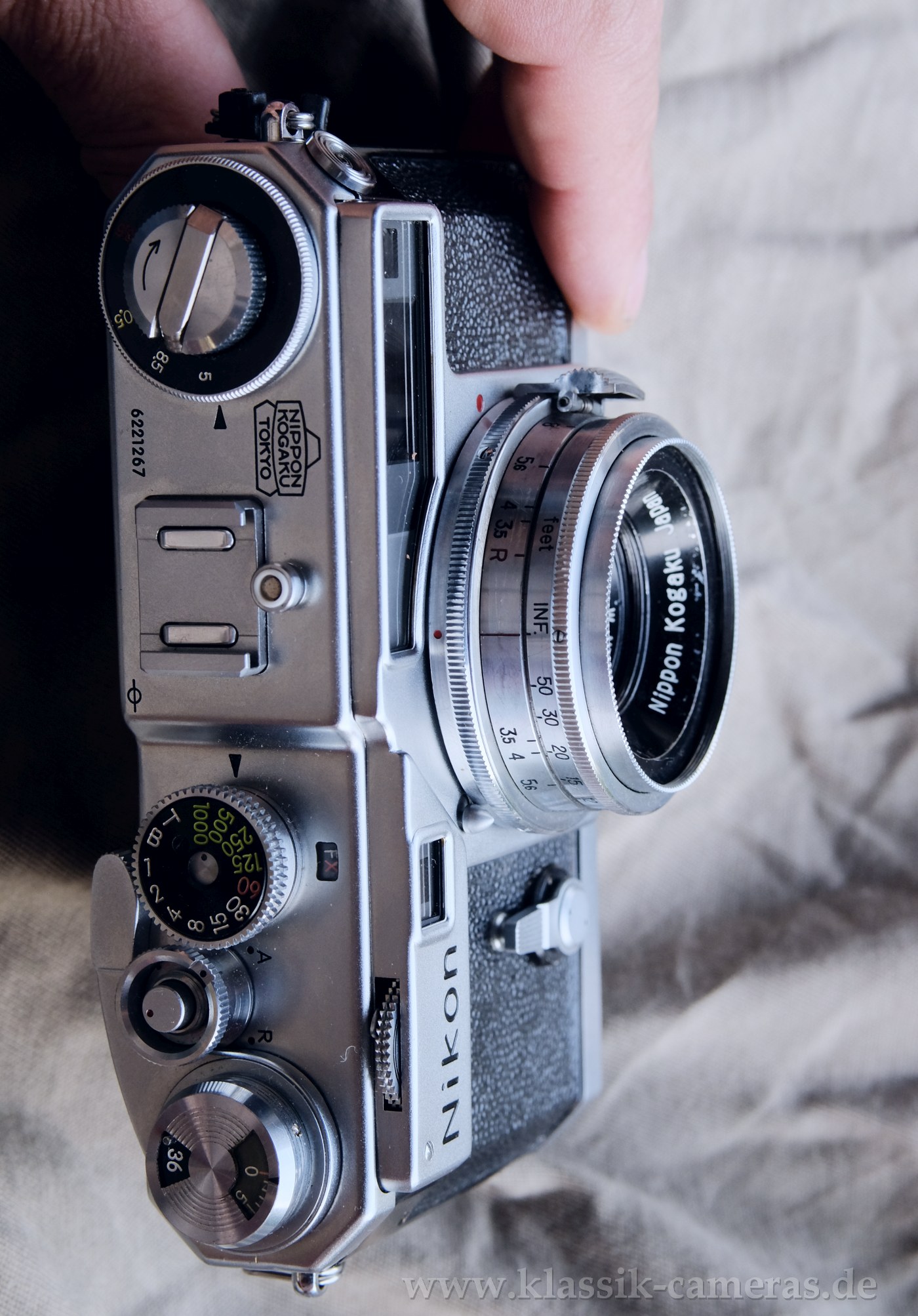
Collector
status after the remakes
Remarkably prices for rangefinder
cameras from NIKON and CANON have fallen over the
past 10 years, while LEICA and VOIGTLÄNDER (Bessa) have been rising.
So you can buy
NIKON's comparatively cheap (consider import duties!)
The cheapest purchase today is the S3 Millenium in chrome. For around 2,000 euros you
get an almost new , top-quality mechanical camera with a modern f/1.4
lens - where else can you find that? The only thing that could be
criticized is missing a TTL
light meter - but it
didn't exist in 1964 either... (except for PENTAX SLRs).
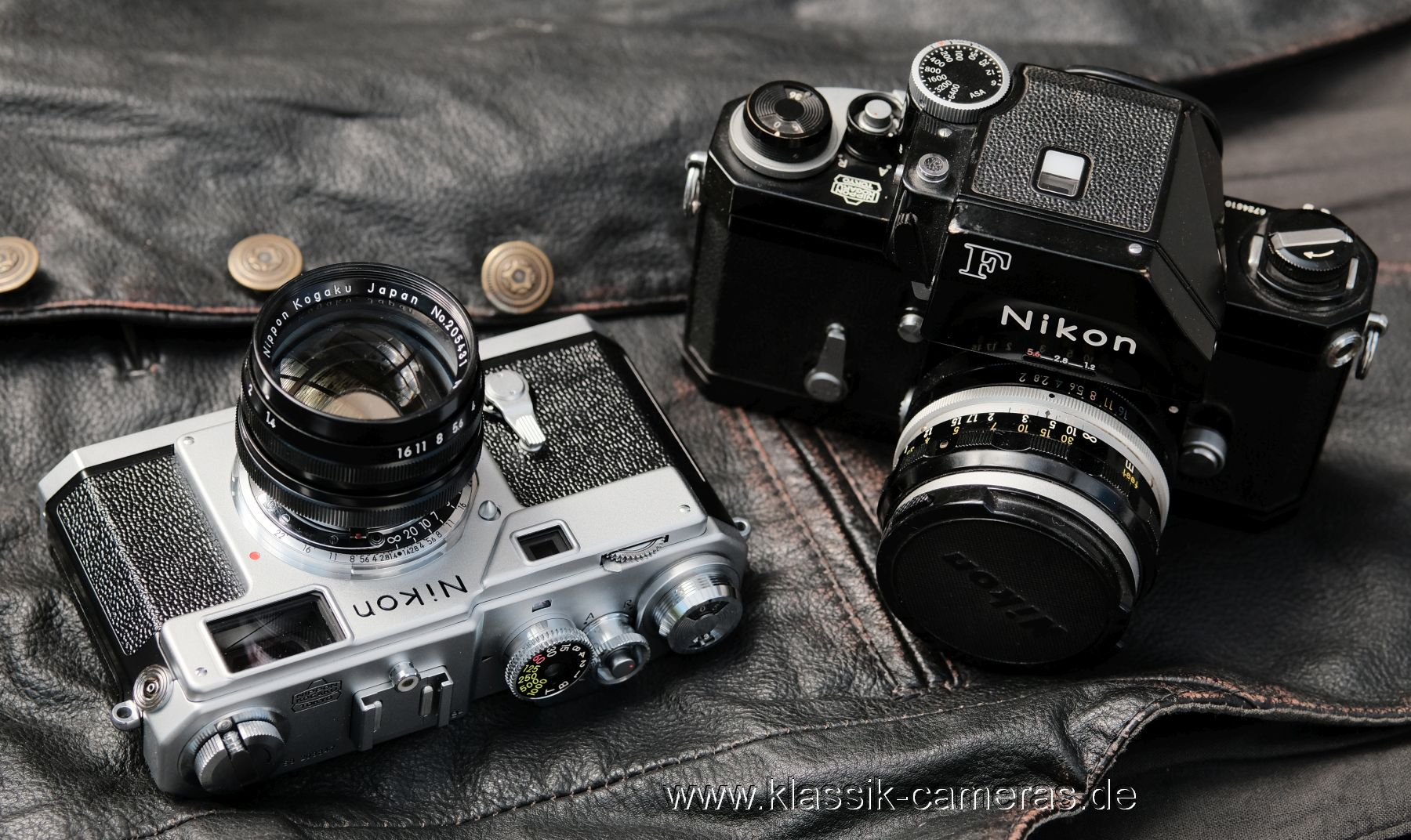
With an AMEDEO adapter, the Nikon S (rangefinder) lenses can also
be used with the LEICA-M (or -L). This adapter contains an
adjustment worm for the focus including a rangefinder coupling. There are two versions of the
adapter: For 50mm lenses (without external bayonet) or (as
shown) for all , for internal and external
bayonet connection. On the Leica, the "Olympic" Nikkor 50/1.4 is one of
the most compact, fast 50's, even with the adapter!
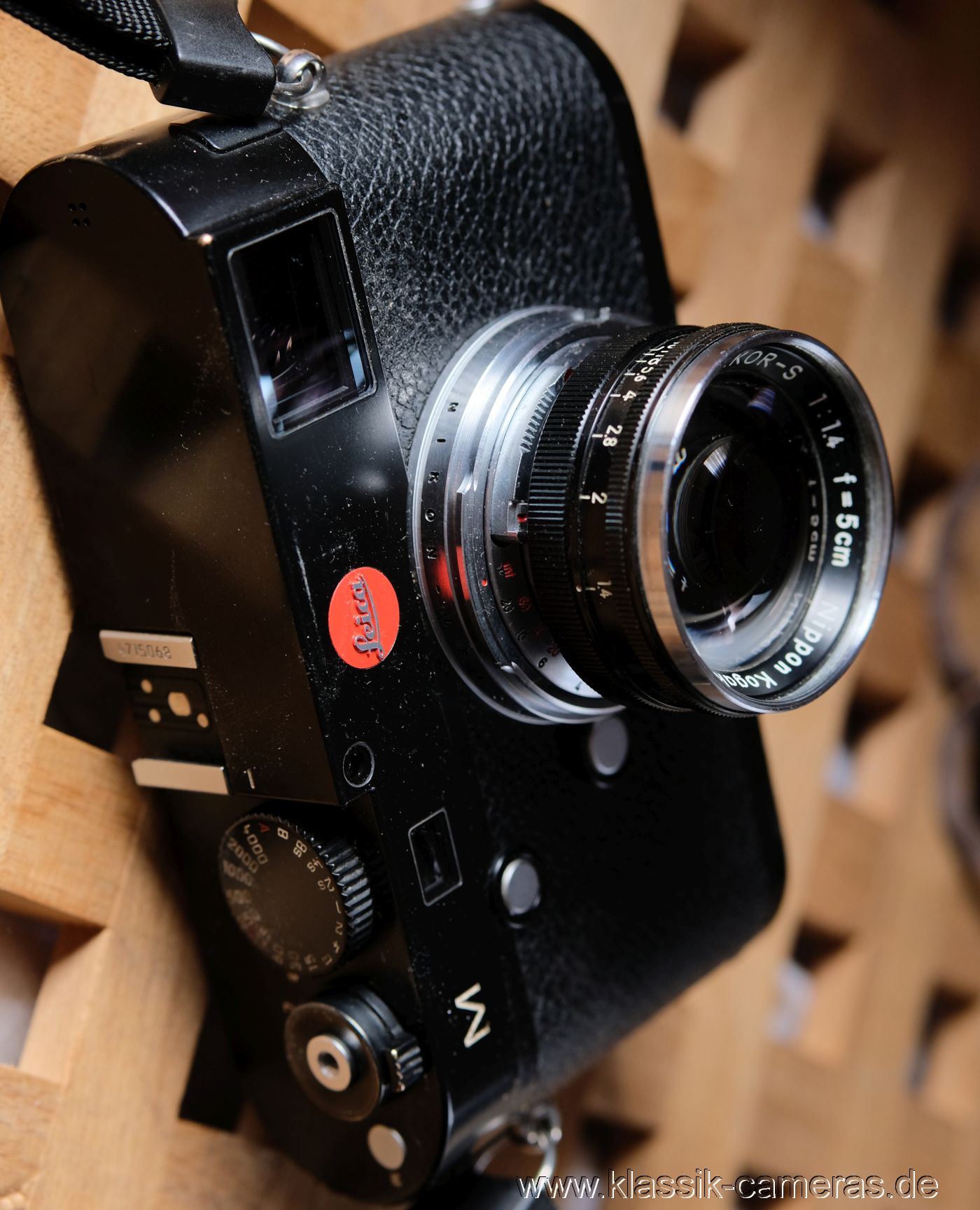
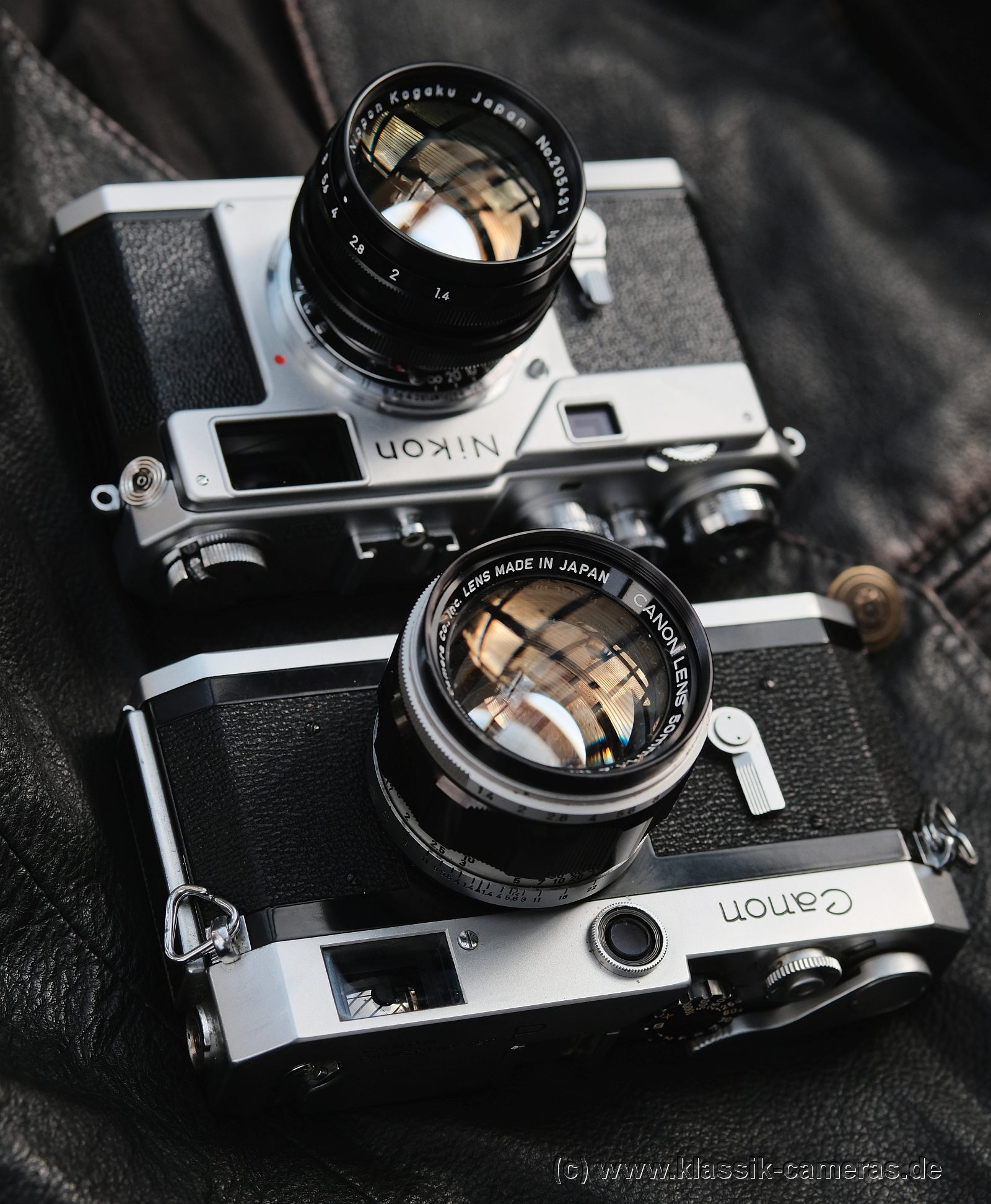
Canon P and Nikon S3
with
their latest 50mm f/1.4 lenses .
Both
cameras had very
similar specs , size
and weight , but
the Nikon S3 costs about 1/3 more than
the Canon P, launched one year later
(1959), and therefore, sold less. Both Nikon S3 and the
Canon P had large, bright lifesize
(1.00x) finders
with brightline framelines for three
focal- lenghts,
35, 50 and 100/105 mm . The
frame lines were et ched
into
the glass, not projected as in
the highest rangefinder
mode ls
(Canon 7, Nikon SP). Canon
P finder has parallax correction,
the more expensive Nikon S3
hasn't!
Both cameras are without
meter, but for the Canon P are easy
to find and cheap Coupled Selenium
Meters available ,
which work reasonably at most light
conditions (except night possibly).
For the Nikon S3 there
were also coupled selenium meters,
but these are very rare and nowadays
mostly dead, plus they give the
whole camera an unwanted SLR look.
Comparison
result: The CANON P is, as the
NIKON S3, a very capable, very
smooth, great useable rangefinder
camera, with the plus of smaller
price, and usability of LEICA
screwmount lenses, which are a bit
more common than S-series Nikkors
.
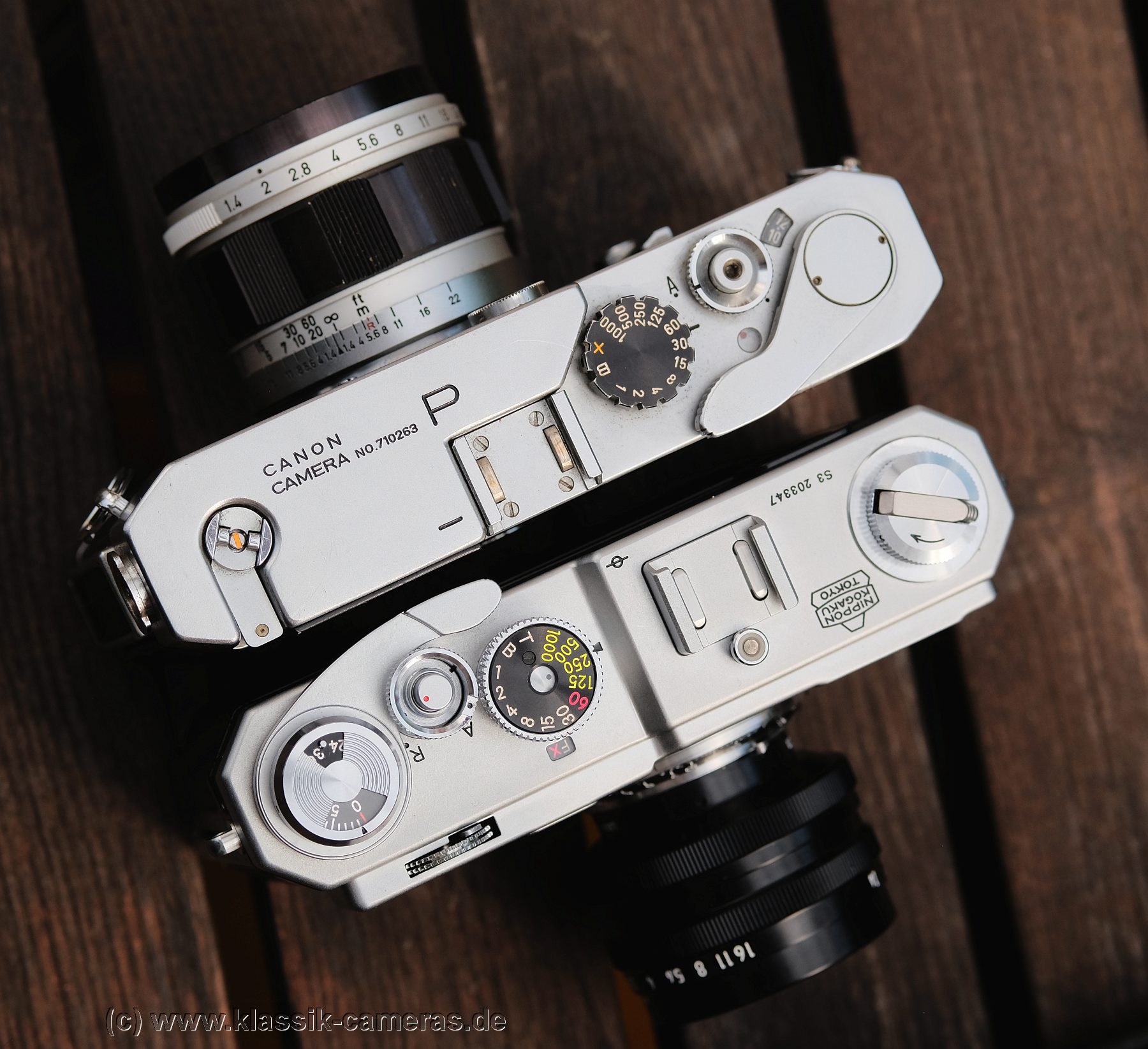
The S3
was sold with the "Sonnar type"
50/1.4 initially, which dated of
1950, whereas the Canon was
available with a new
one"Planar
type" 50/1.4 launched in the same
year as the camera, 1959, which
received excellent reputation. So
Nikon created a Planar type 50/1.4
lens as well, the so called
"Olympic" lens, which was issued to
the public as late as 1964, when
their last series of rangefinder
cameras were sold.
the
last Not
yet. The
S3 shown here is the "Millennium"
remake ,
issued 2000.
Plus
there was a final SP
remake in
2005.
External Link: What happened
if...? -- NIKON
Rangefinder Prototypes (SP2/ SPX) a
Great
article with pictures by Robert Rotoloni,
at Mike Eckman's website
Nikon SP2 +
Prototype Lens Nikkor-S 1:1.4 f=35mm
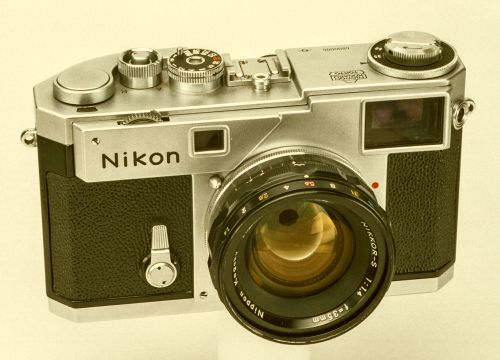
Nikon SP2 + Prototype Lens Nikkor-S 1:1.4 f=35mm
Nikon
S3 and SP in practice
A beautiful Nikon SP now complements my NIKON RANGEFINDER collection. The viewfinder field is a bit
smaller than on the S3: you can barely see the 50mm frame with
glasses; with
the S3 with 35mm. I would say that for people who mostly shoot with 35 or 40mm , the S3 is clearly the
better camera. The
SP is the most suitable for those who use a lot of telephoto lenses . Since
the parallax correction of the SP is also more important.
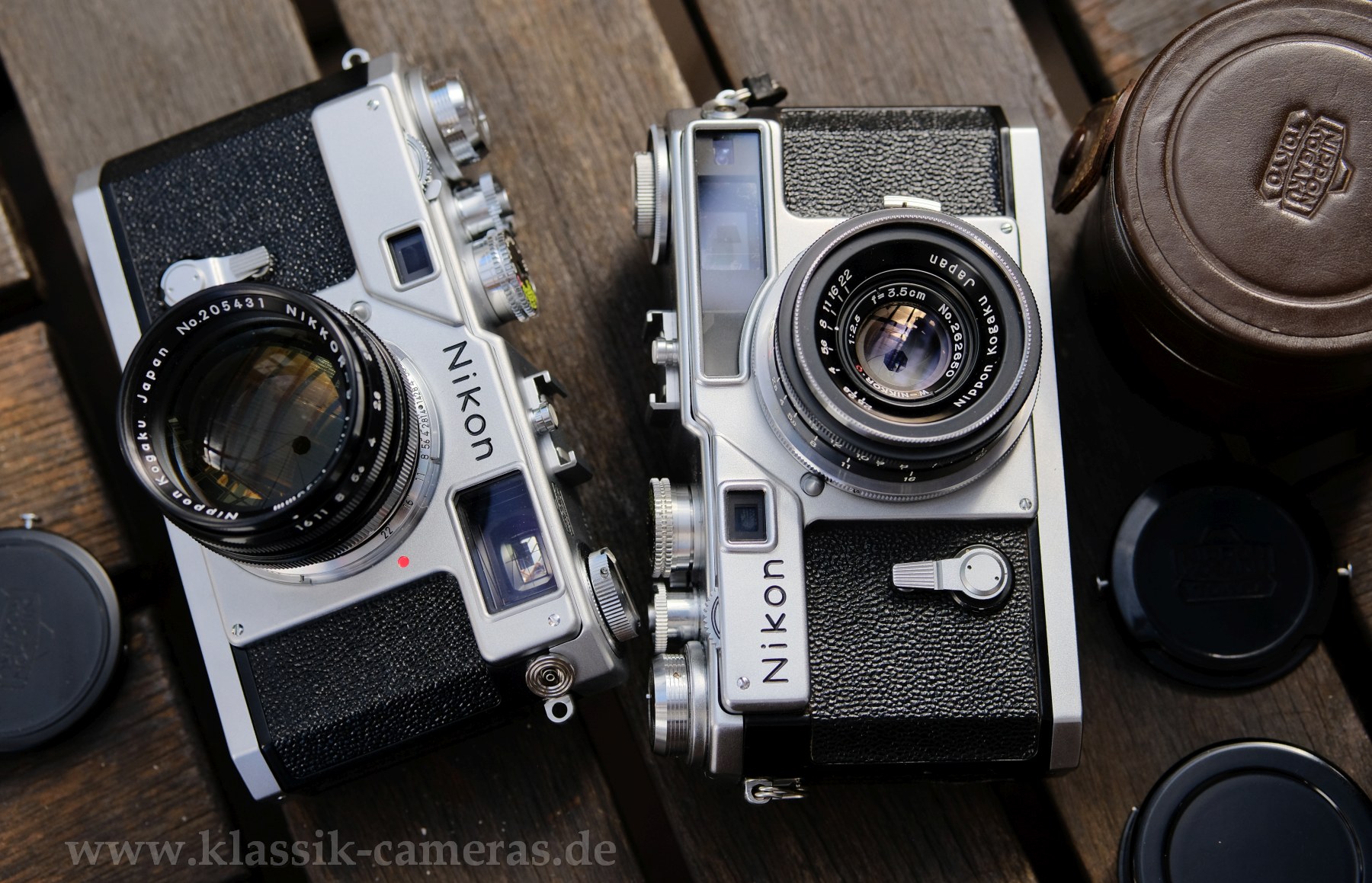
Both cameras are very easy to handle , with all the adjustment levers and
wheels being mechanically
strict for today's tasteswalk, but don't pretend to do it yourself. Both cameras are sufficiently
compact but not tiny (WxHxD 136 x 81 x 41 mm) and weigh 590g
each (like the Leica M3).
The rangefinder (1.00x,
lifesize, as with the S3) has 4 frames that can be added using
the rotary ring: 50mm is always visible, the others are added
up, so that with the 13.5 position there are also 105 and 85
next to the 50mm can be seen (the 135 frame is red-orange, the
others are yellowish). The visibility of the frames is sufficient - on the
S3 they are more visible, bright, almost too dominant.
The measurement spot is
clearly visible - of course not as distinct as on Leicas or
Bessas from the 2000s. The viewfinder of the S3-2000 is neutral in color -
that of the SP has a slightly greenish tint - as withmy almost 70 year old S2 too. And
the SP has at most 10
years less under its
belt. She did
well for that!
The wide-angle viewfinder of the SP (28/35) - view on the far left, small but
not too small - has no measuring
spot. Both
cameras - the S3 and the SP - already have a glasses-friendly
plastic collar around the viewfinder eyepiece. The viewfinder of the S3 is larger than the SP.
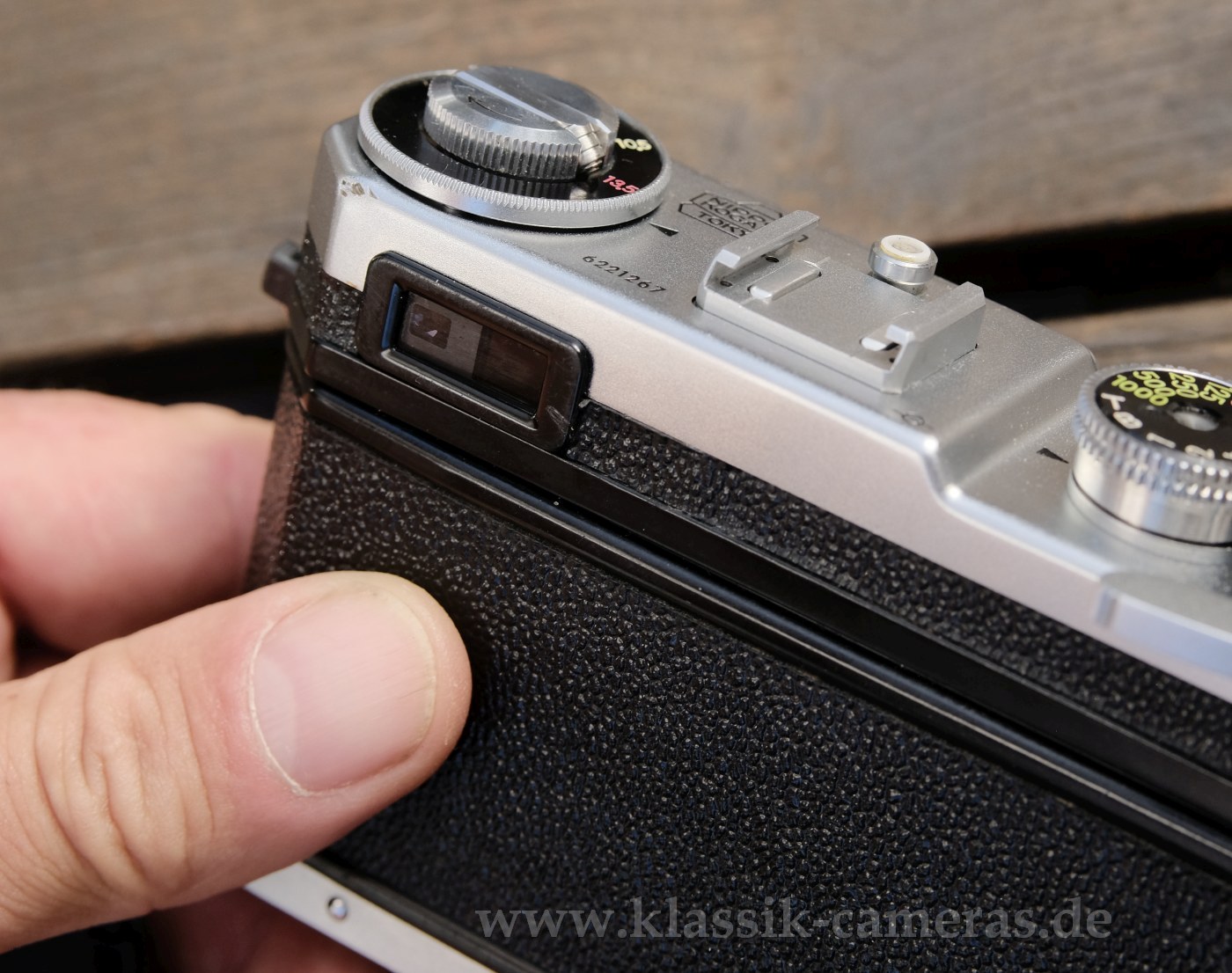
|
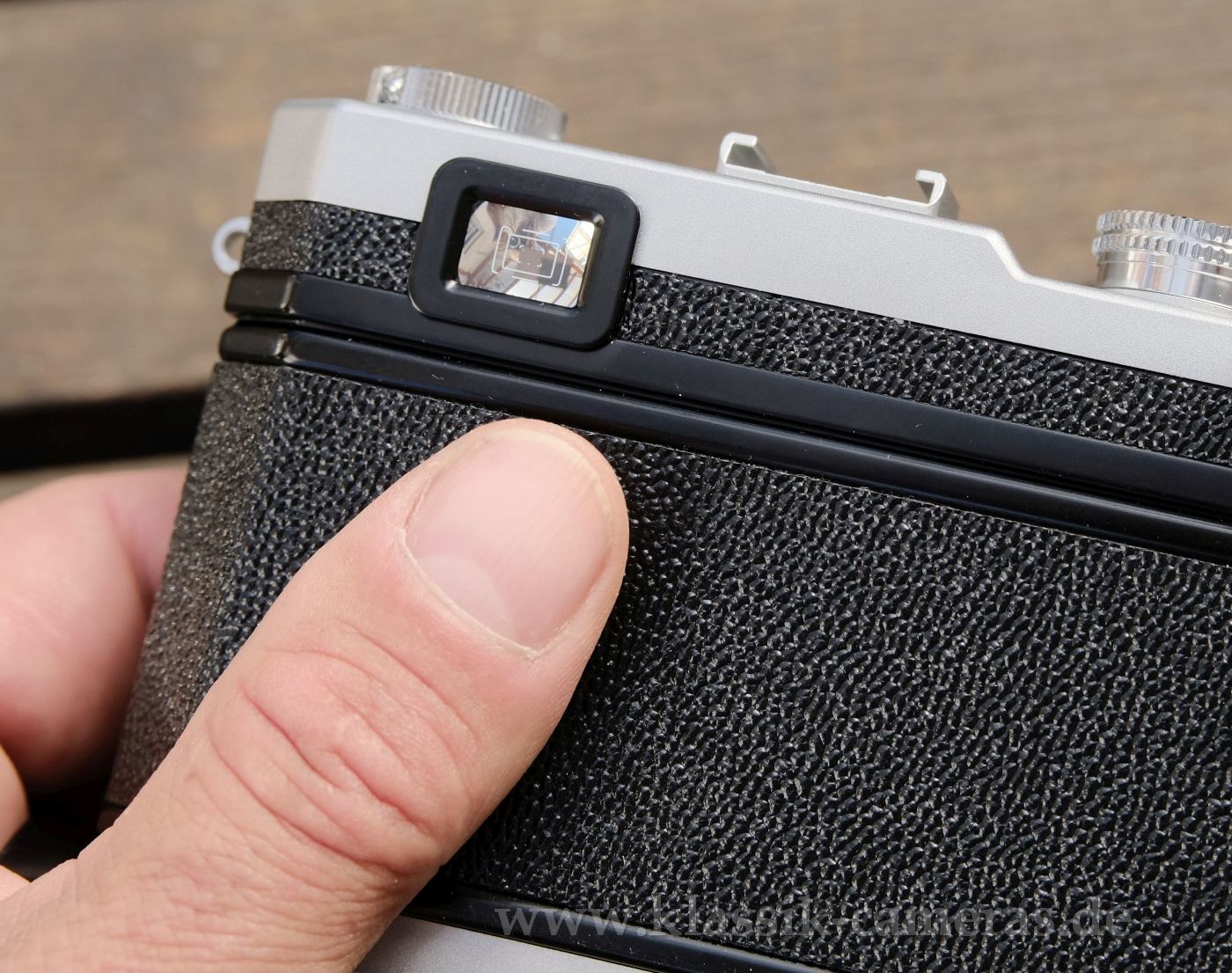
|
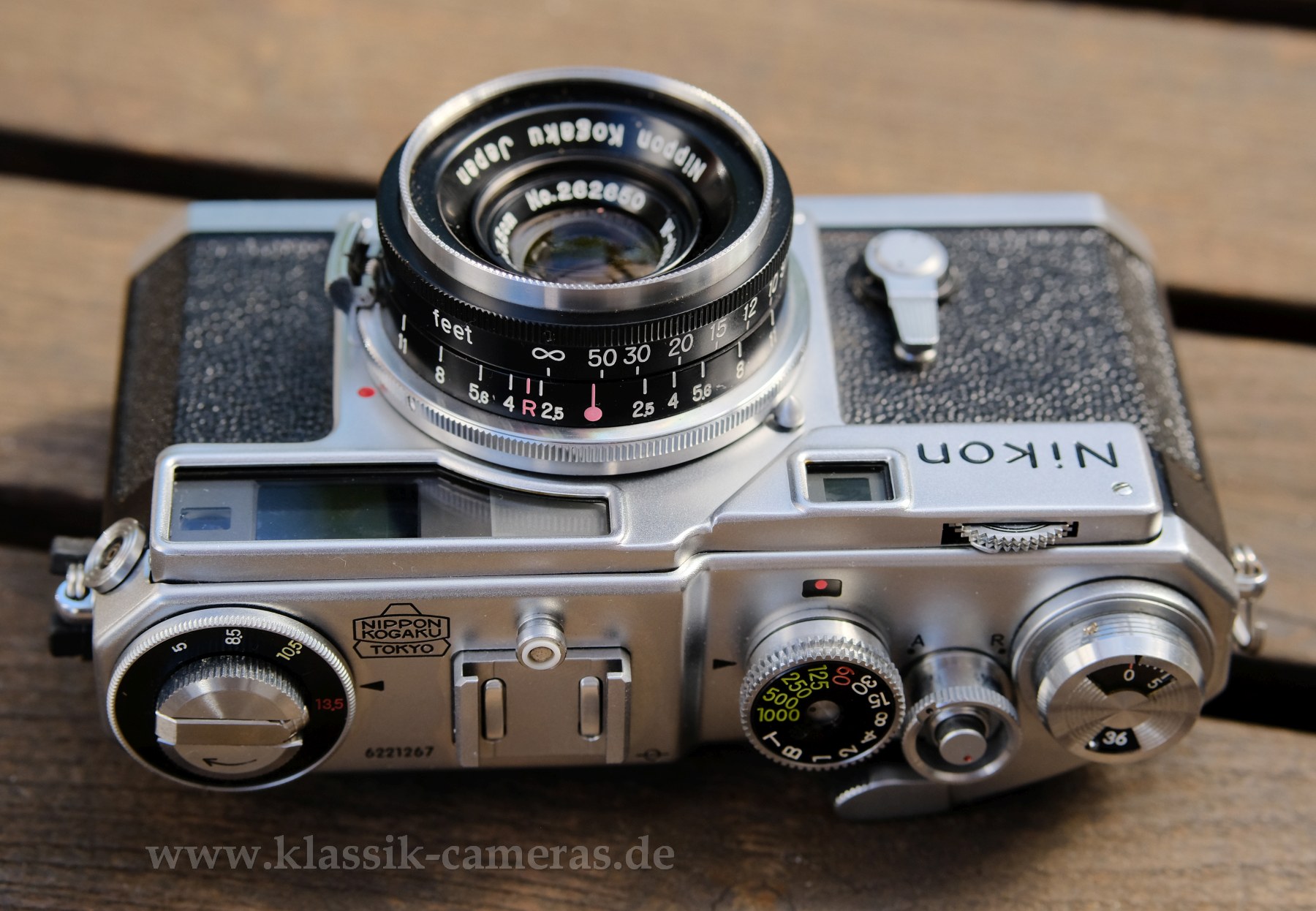
|
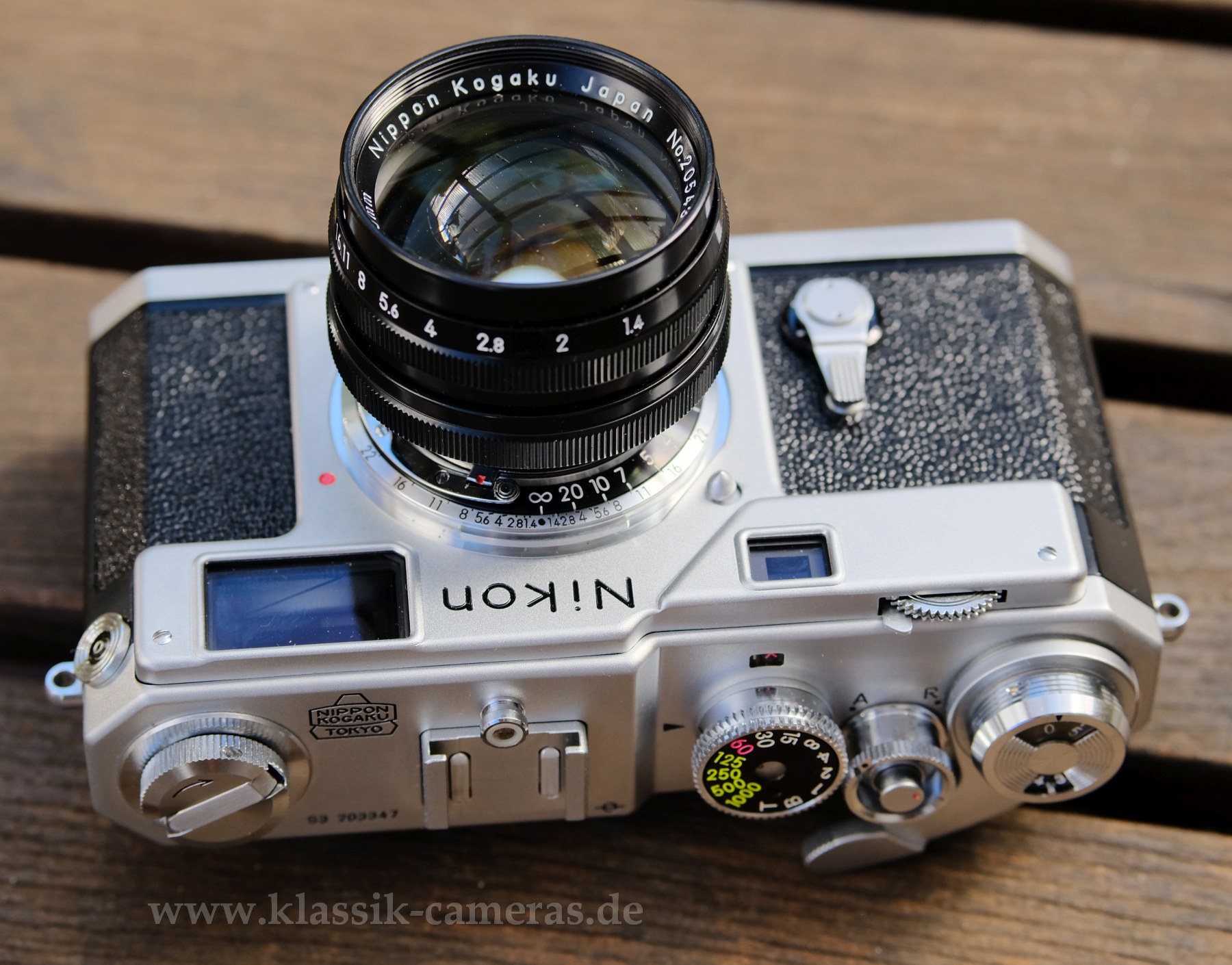 |
From
the SP (1957), the NIKON F (1959) got the timelessly functionally designed
controls and most of the mechanics (it is 11mm wider and 95g
heavier because of the mirror box).
Everyone considers the SP to be the
pinnacle of the NIKON S series, and of course it was the most
sophisticated and expensive. But the S3 is by no means
the worse camera. Which of the two you prefer is purely a matter of taste
in terms of appearance and the viewfinder. It's fair to say that the
SP's more complex viewfinder is also more susceptible to dust
and aging. Because
apart from the viewfinder, the cameras are identical. Identical?Not 100%, because my SP is a late version, with
a titanium lock , which Nikon had taken over from the mirror reflex F -- but only
the SP, not the S3, got it. You almost can't tell it's
metal, it's so thin. The S3 with cloth shutter triggers slightly quieter, so it's more the model for street
photographers.
Nikon Main Page
Camera Main Page
















